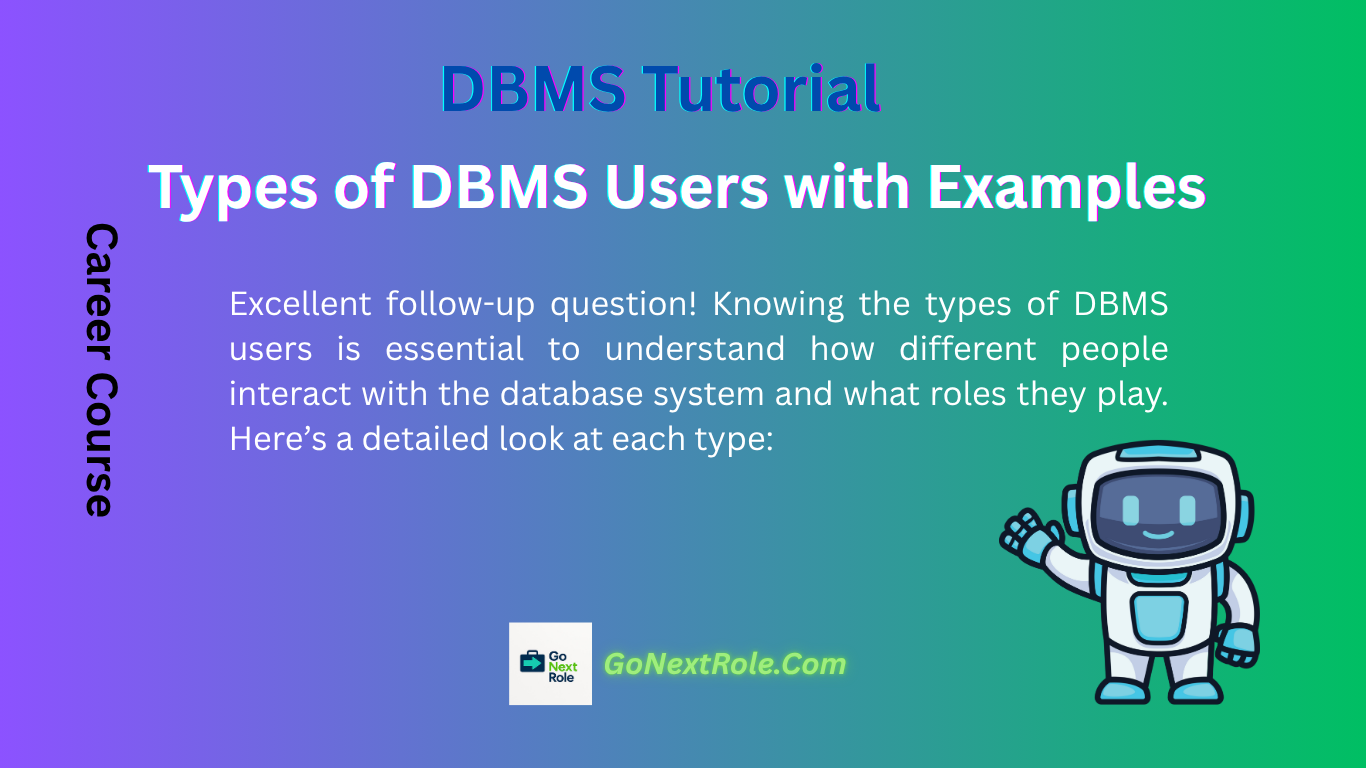Entity-Relationship (ER) Model in DBMS with Examples
Absolutely! Here’s a detailed explanation of the Entity-Relationship (ER) Model in DBMS, including core concepts, types of relationships, constraints, diagram notations, and examples:
Career Course Tutorials DBMS Tutorial
📌 1. What is the ER Model?
The Entity-Relationship (ER) Model, introduced by Peter Chen in 1976, is a high-level conceptual data model. It visually represents the structure of a database with entities, attributes, and relationships.
- It’s used in database design to capture real-world requirements and convert them into relational schemas.
📌 2. Core Components of the ER Model
🔹 Entity
- An object or thing in the real world with independent existence.
- Example:
Student,Employee,Car.
Entities are represented by rectangles in ER diagrams.
🔹 Entity Set
- A collection of similar entities.
- Example: All students form a
Studententity set.
🔹 Attribute
- A property or characteristic of an entity.
- Example: Attributes of
Student– RollNo, Name, Age.
Attributes are represented by ovals connected to their entity.
🔹 Types of Attributes
✅ Simple Attribute – Indivisible value (e.g., Age).
✅ Composite Attribute – Can be divided into smaller subparts (e.g., Address → Street, City, Zip).
✅ Derived Attribute – Value computed from other attributes (e.g., Age derived from DOB).
✅ Multi-valued Attribute – Can have multiple values (e.g., PhoneNumbers).
🔹 Relationship
- An association among two or more entities.
- Example:
Enrollsrelationship betweenStudentandCourse.
Relationships are represented by diamonds in ER diagrams.
🔹 Relationship Set
- A set of similar relationships.
📌 3. Types of Relationships (Cardinality)
Relationships have cardinality constraints specifying the number of entity instances involved:
✅ One-to-One (1:1)
- One entity of A is associated with one entity of B.
- Example: Each person has one passport.
✅ One-to-Many (1:N)
- One entity of A can be associated with multiple entities of B.
- Example: A teacher teaches many students.
✅ Many-to-One (N:1)
- Many entities of A associated with one entity of B.
- Example: Many employees work in one department.
✅ Many-to-Many (M:N)
- Many entities of A can associate with many entities of B.
- Example: Students enroll in many courses; courses have many students.
📌 4. Keys in ER Model
✅ Primary Key – Attribute(s) uniquely identifying an entity.
✅ Candidate Key – Minimal set of attributes to uniquely identify an entity.
✅ Composite Key – Key consisting of multiple attributes.
📌 5. Participation Constraints
Participation describes whether an entity’s involvement in a relationship is:
✅ Total Participation (Existence Dependency)
- Every entity must participate at least once.
- Example: Every student must enroll in at least one course.
✅ Partial Participation
- Some entities may not participate.
- Example: Some employees may not manage any project.
📌 6. Weak Entity
A weak entity cannot be uniquely identified without a related entity (called the owner entity).
- It depends on a strong entity and uses a partial key.
- Represented by a double rectangle in ER diagrams.
- The relationship connecting a weak entity to its owner is a identifying relationship (double diamond).
Example:
Paymententity weakly depends onLoan.
📌 7. ER Diagram Notations
- Rectangle: Entity sets.
- Oval: Attributes.
- Diamond: Relationships.
- Double rectangle: Weak entities.
- Double diamond: Identifying relationships.
- Dashed oval: Derived attributes.
- Lines: Connections among entities, relationships, and attributes.
- Multi-valued attribute: Double oval.
📌 8. Example ER Diagram / ER diagram examples with solutions
Here’s a simple example:
+-----------+ +------------+
| Student | | Course |
+-----------+ +------------+
| | | |
RollNo Name CourseID Name
| |
+------------<Enrolls>---------+
(M:N)
- Entity sets:
Student,Course - Relationship:
Enrolls(many-to-many)
📌 9. Extended ER (EER) Model
For complex designs, the EER Model introduces additional concepts:
✅ Generalization – Top-down; combining similar entity sets into a generalized entity (e.g., Vehicle generalizing Car and Bike).
✅ Specialization – Bottom-up; dividing an entity set into specialized sub-entities (e.g., Employee specialized into Manager and Engineer).
✅ Aggregation – Modeling relationships involving relationships themselves.
📌 10. Steps in ER Modeling
1️⃣ Identify entities & entity sets.
2️⃣ Determine attributes for each entity.
3️⃣ Identify relationships among entities.
4️⃣ Determine cardinality & participation constraints.
5️⃣ Draw the ER diagram.
6️⃣ Convert ER diagram to relational schema.
✅ Advantages of ER Model
✔ Intuitive and easy to understand.
✔ Good for initial conceptual design.
✔ Helps visualize data requirements clearly.
✔ Serves as a blueprint for building relational databases.
Would you like help converting an ER diagram to a relational schema, or do you need a practice exercise on ER modeling?
Free career development courses
Relational Model Concepts in DBMS
Types of DBMS Architecture Tutorial
Types of DBMS Users with Examples



